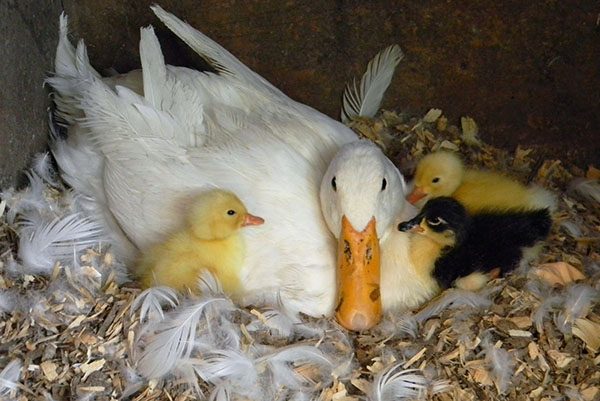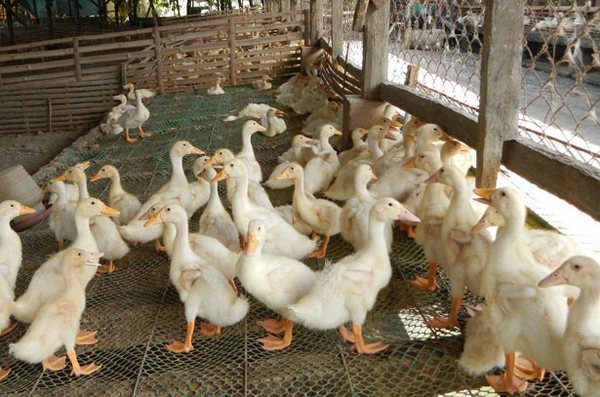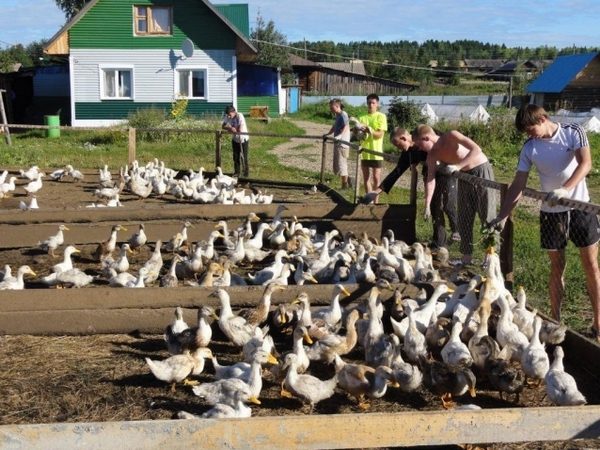Duck is a fairly common poultry in the rural farmstead. It can often be found in the countryside, especially if there is a reservoir. Ducks are grown to produce meat. By the age of one month, young animals weigh up to 2.5 kg. An adult drake weighs about 4 kg. In addition, ducks lay eggs up to 120 pieces during the year.
In this article we will talk about breeding and growing ducks at home for beginners. In addition, we will learn how to properly feed the ducklings at home, what are the mash, feed, what is their composition.
Table of contents
- How to breed and grow ducklings for beginners?
- Growing and breeding ducklings hen
- How can you breed ducklings in an incubator and how much time is needed for this?
- Proper maintenance and care
- How to feed the ducklings: feed, mash and vitamins do it yourself
- Feeding in the first days of life
- What feeds should be given to individuals from one to three weeks?
- How should ducks eat from one month before slaughter?
- How to keep adult ducks at home?
How to breed and grow ducklings for beginners?
The content of ducks in the home for beginners is not much different from the cultivation of chickens or geese. But, There are some nuances that should be considered when breeding this bird. They should definitely stay in more detail. Including on how many ducks live.
Growing and breeding ducklings hen
An interesting point is that duck eggs can be laid under a chicken or a turkey, and they will hatch eggs, taking them for their own. But a duck or a goose is unlikely to want to do the same with alien eggs. So, as a hen choose any of the three domestic birds - chicken, duck or turkey. Of course, it is better if it is a duck.
Up to 15 eggs are usually placed under the duck if the brood is planned to be received in the summer and up to 12 - in the spring.This is due to the ambient temperature. Naturally, under the turkey put more eggs, which is explained by its large size, and under the chicken - less. The main thing is that all eggs in the clutch should be under the hen in order to evenly heat the hen body.
For the hen they make a nest of straw in the shape of a wreath so that the eggs do not roll in different directions. The rest of the components (eg, feathers) the hen itself will add. On the bottom of the nest, if it is located on the floor, put sawdust and chaff.

It is better to make the nest on a small hill and away from direct sunlight, in the darkest part of the house. Artificially pritenyat this place is not necessary. If it seems uncomfortable to you, make an improvised partition. This will separate one nest from another and create a feeling of additional comfort.
The first brood is received on day 27 after the start of incubation.
After 1 to 2 days, all chicks should hatch. So that the hen doesn’t slap them, the ducklings are taken into a separate box immediately after birth. To do this, you can take a cardboard box, strewn with straw and sex. The normal temperature for them at this time is 30 degrees.Therefore, if the brood turned out in the spring, take care of an additional source of heat.
After all the ducklings are born, they are returned to the hen - the duck. Better to do it in the evening. Make sure that the duck mother takes them to her, because during this period the chicks especially need warmth.
How can you breed ducklings in an incubator and how much time is needed for this?
The main advantage of growing ducklings in an incubator is the opportunity to get a brood at any convenient time. In addition, do not worry about the hen, and the incubator can be made with your own hands. Modern home incubators are equipped with temperature and humidity controllers. Therefore, you just have to follow the process, turn the eggs (if it is not provided for automatically by the incubator design) and occasionally open the apparatus for a small short-term cooling and to remove accumulated gases.
Before laying the incubator is heated, setting the temperature to 1-2 degrees higher than necessary for incubating eggs at the very beginning of the process. Besides, It is recommended to make high humidity. To do this, on the tray set several trays with water.
Due to the fact that the shells of duck eggs are stronger than the hens and they are larger in size, somewhat different in chemical composition, the brood appears later.
In the first week after laying the temperature in the incubator should be at 38 degrees (the first 3 days - 38.2, the next 4 - 37.8). Humidity is required to keep at 60%. After two weeks of eggs in the incubator twice a day, it is worthwhile to open the incubator door for 30 minutes, reducing the temperature to 32 degrees. Then the temperature is resumed.

If there is an ovoscope, you need to check the eggs for the presence of embryos after 9-10 days. Do not allow a sharp drop in air temperature. Chicks appear on the 27-28th day for one or two days. Humidity is maintained at 55%. After the chicks have dried, they are transferred to a box, basket, box, pre-laying dry sawdust, chaff, and straw on the bottom.
Proper maintenance and care
In the first 20 days of life, ducklings need increased attention in respect of compliance with the temperature regime. If they are close to a duck, you should not worry about an additional source of heating - the duck itself is able to protect them from low temperatures. In the first week of life, the temperature should be maintained at the level of the litter of 27-30 degrees; in the second week - 23-26, in the third - 19-22. Then they get used to the natural temperature of the air.
As mentioned earlier, the litter should be dry. Otherwise, ducklings freeze and get sick.
The length of daylight at the beginning of life should be at the level of 20 hours with a gradual decrease to 12 hours at one month of age.
Ducklings with a duck in the morning and in the afternoon let out a walk after five days of age. In the evening, closed in a room with additional heating, if the air temperature is below the above marks. And after three weeks of age, they can be left outside the premises around the clock.
The presence of the reservoir is very good for raising ducklings. With an adult bird they are released into the water after three weeks of life. Independently - after a month. You can keep ducklings in cages in the first two weeks. Then they are given more freedom. That is, partially walking. Monthly youngsters are transferred completely to the maintenance of walking.

How to feed the ducklings: feed, mash and vitamins do it yourself
Feeding the ducklings at home for beginners is simple. Youngsters quickly get used to getting food at one time. Therefore, do not have to teach them in addition to a specific diet. In ducklings growth and weight gain occurs quickly. At three weeks of age, it weighs about half a kilogram, after six weeks it weighs an average of one and a half kilograms, and in 2.5 months it can already be scored, since the weight reaches two and a half kilograms.
But it is better to slaughter them before the onset of frost, since in summer and autumn the main ration of food for ducks is greenery and all that they find on the pond themselves. That is, you have to spend a little on food.
You may also be interested in useful articles:
- All about incubating duck eggs at home.
- how grow broiler ducks at home.
- How to breed Peking ducks on his farm.
- Description, features and advantages ducks agidel.
Feeding in the first days of life
Feeding ducks at home in the first week occurs 6-8 times during the day. You can make a schedule so that the first feeding was early in the morning, the last - before dusk. Finely chopped boiled eggs, low-fat cottage cheese, and other milk-based products are the main ration of ducklings during this period.
It is advisable to give food from narrow troughs, since wide dishes in the form of a roaster contribute to the fact that the ducklings simply trample the main mass of food. Drinking bowls should not be placed next to food, as the latter quickly becomes wet, and the water - dirty.
The fact is that a duck is a waterfowl. At the very young age, she manifests an instinct to eat food, which is either in the water, or drink it immediately after being hit in the beak. Thus, if you put the trough away from food, the duckling, until it reaches the level of the drinker after a meal, the main mass will be swallowed. Thus, it is possible to keep clean water.By the way, it is recommended to dilute a little potassium permanganate, but in such a dosage that he could not paint the water pink.
After five days, begin to prepare mash for ducklings from the above products with the addition of ground corn and wheat sack.
What feeds should be given to individuals from one to three weeks?
What to feed small ducks at home? After a week of life, ducklings are taught to be green, because in the future it will become the main food in the diet of this bird. At this age, the duckling eats about 40 grams of various feeds. Gradually reduces the proportion of boiled eggs and dairy products, replacing them with large portions of wheat and corn sour. In the diet added feed of animal origin: fish and meat and bone meal.
By two weeks of age, a duckling needs about 60 grams per head. By this period, boiled egg, cottage cheese and other dairy products are completely excluded from the diet. Instead, they give more greenery. Ideal if it is a duckweed.She is happy to eat this bird in almost unlimited quantities. At the same time begins an intensive growth and weight gain.
We should not forget that the growing duck eats much less. After 20 days of age, ducklings are released into the pond with duck mother.
You can use "dry" feeding, in which the basic ration will be purchased feed for ducklings. In this case, their cultivation will be more expensive, but the ducklings grow faster.
How should ducks eat from one month before slaughter?
How to feed the ducks at home in a month? Dirt of various cereals, millet, meat and bone and fish meal, shells, chalk, sunflower oilcake, fodder yeast and greens - these are the components that make up the diet of young animals during this period of life.
In addition, grazing them on the pond diversifies food and reduces the cost of the content by about 2 times. The total part of the diet in the diet is 40%, greens - 30%. If the duck has the ability to eat duckweed, then the component of greens in the diet increases one and a half times.

How to keep adult ducks at home?
An adult duck (drake) can weigh from three to four kilograms, depending on the breed. The most common breed of duck meat breeds.
- Beijing: growing and gaining weight quickly, good tolerates winter. Two-month-old young animals have a live weight of about 2.5 kg. The adult duck is up to 3.5 kg, and the drake is up to 4 kg. Egg production - up to 110 eggs per year. The meat is delicious.
- Bashkir color: meat of excellent quality, well adapted to the new conditions of detention, the fat content is low. Productivity is high.
- Black white tits: the weight of an adult duck is 3-3.5 kg, the drake is up to 4 kg. The meat is delicious. A distinctive feature of this breed is increased egg production - up to 130-140 eggs per year.
- Moscow white: The weight is the same as that of the black white-breasted man. The meat is very tender and tasty. Egg production is high - up to 160 pieces per year.
- Gray Ukrainian: the live weight of drakes is 3-3.5 kg. Ducks - up to 3 kg. Egg production is very high and sometimes reaches 220 pieces per year.
Among the meat-egg and egg breeds, the following can be noted.
- Khaki-Campbell - meat and egg breed ducks. Differs calm character. The average egg weight is 75 g., Egg production is up to 330 pieces.The weight of the drake is up to 3 kg, the duck is up to 2.5 kg.
- Indian runner - egg breed. Got its name because of its high mobility. Egg production and weight is similar to Khaki-Campbell. To taste the meat is like chicken.
To determine the choice of breed, you need to decide for yourself for what purpose you are going to breed them. Meat breeds weigh more, egg production is less, in meat-egg and egg breeds - on the contrary. White and French ducks are also good for growing.
Ducks are kept indoors or by walking. In the first case, they should be fed more intensively due to the combined feed and low mobility of the bird.
The room should be well ventilated, moderately bright and warm. The adult duck tolerates winter well, but it is better that the room during this period does not fall below 5 degrees Celsius. On 1 square. m square bred 4 ducks.
Walking method for this bird is better. But it depends on the ability to do such walking and the presence of a reservoir. In this case, it is better to split the livestock into small groups - 10-15 heads each, separating them with low partitions. From reservoirs shallow rivers and lakes are preferable. Rounds fenced low fence.They can be made adjoining poultry houses, so that ducks can, if they wish, hide in a covered room.

Food is the same as for the young. Emphasis is placed on the grain crops and corn, with more corn in the composition. Do not give the ducks breadcrumbs, which adversely affects the poultry's digestive system.
It is also forbidden to give no fresh mash. In general, if there is a suspicion about the quality of the feed, it is better to refrain from feeding them the bird. Do not forget to give a green mass or let out for pasture on pasture, if not near the reservoir. If there are nearby rates or a lake - drive them there. On it, the ducks will find the bulk for their food.
If you feed the ducks with non-purchased feed, their composition may be as follows:
- 40% of the derti mixture of grain crops, of which at least half - corn;
- 30% green mass;
- 10% grain waste;
- 7% cake and meal;
- 7% feed of animal origin;
- 6% shells, chalk, fodder yeast, vitamins, other mineral supplements.
It is very important to give ducklings and adult ducks vitamins, especially in the autumn-winter and winter-spring period, when there is not enough sunshine and no greenery at all. If it is difficult to buy vitamins, you can use brewer's yeast, which contain a lot of proteins, carbohydrates and fiber.
There is nothing difficult in breeding ducks. The main thing at the initial stage of their cultivation is to be attentive to the feeding processes, to give balanced food and find a place for walking and a body of water for them. Then not only your family will be with tender and tasty meat, but you will also be able to more than cover the cost of maintaining this bird by selling surplus products.

Thank you for the article! A question. We have a shallow, muddy pond with running water on the plot. If we let out ducks there for walking, will the reservoir become a breeding ground for infectious diseases?
Helen, do not turn. My grandfather also had a small muddy pond. The ducks felt great there.